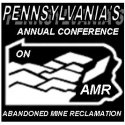
EPCAMR Staff feels this is the most extensive recount of coal mining impact on those who live in and work in the coal region by a newspaper investigation. Thank you, Scranton Times, for working with us!
Investigation Navigation
________________________________________
Part 1 – 1/30/2005
Too Many Mines, Too Little Money
State Program Trying To Make Up for Lost Federal Contributions
Part 2 – 1/31/2005
Danger Lurks in Mines
Part 3 – 2/1/2005
Mining for Solutions
Competing Plans
Successful Reclamation Results are All Around
Orange Water, Silver Lining
________________________________________
State Program Trying To Make Up for Lost Federal Contributions
BY BORYS KRAWCZENIUK THE SUNDAY TIMES 1/30/2005
Pennsylvania has tried to fill gaps in federal funding for cleaning up abandoned mine lands with streams of state tax dollars.
The state funding flow amounts to little more than a drop in the bucket, though, and its main program for cleanups — Growing Greener — pays for public works projects far beyond mine lands.

Hundreds, perhaps thousands of tires lie in the bottom of the mine hole in Plymouth off of Jersey Road and Route 11. (Edward Pikulski)
The program supplied more than $438 million for hundreds of environmental-related projects between 1998 and 2003, including 91 in seven Northeastern Pennsylvania counties, according to review of state Department of Environmental Resources records.
The work included stream-bank erosion control, the restoration of wetlands, buying up open space to thwart urban sprawl, controlling pollution and plugging oil and gas wells. The 91 projects included only 12 for abandoned mine reclamation.
Lackawanna County alone has at least another 119 abandoned mine sites, Luzerne at least another 211.
The decades of cleanups included a $200 million bond issue in the 1960s. The state has cleaned up about 400 mine sites in total but has roughly 2,075 left. The estimated cost of cleaning them up is $4.9 billion.
“At the rate we’re going, it’ll be a century before we completely clean them up,” said state Rep. Edward G. Staback, D-Archbald. Three projects are about to begin in his legislative district, which covers the Midvalley and part of Wayne County.
However, the state Department of Environmental Protection estimates a total cleanup will take hundreds of years at the current rate.
FUNDING STRUGGLE
Started by then-Gov. Tom Ridge in 1998, the Growing Greener program has occasionally struggled with its funding. When the state’s budget was facing deficits in 2002, the program got squeezed. The program had $139 million but that was down to $107 million in fiscal year 2003-04, Gov. Ed Rendell said.
Both factors played into Mr. Rendell’s proposal to create Growing Greener II, which he unveiled during his budget address last February. He proposed selling $800 million in bonds and making payments from new or higher taxes on big polluters and the landfill industry. An industry tax already funds the current program.

Justin Taylor walks along a mined area near Russell Park in Carbondale where a mine fire has been evident. (Michael J. Mullen)
“If we can get Growing Greener (II) passed … that would certainly put us ahead of the curve,” Mr. Staback said.
After agreeing to borrow about $1.1 billion for economic development last year, though, some Republicans are squeamish about borrowing again for another Growing Greener. But they mostly fear that increasing taxes on industries will end up costing consumers more and hurt the competitiveness of industries especially manufacturers.
“I think it comes down to the fees,” said Drew Crompton, an aide to state Senate President Pro Tempore Robert C. Jubelirer, R-Blair. “At a time like this, when you’re losing manufacturing jobs, you shouldn’t add to their tax burden. There is some tendency to forget that the original Growing Greener will last for many years. It’s not as if it’s running out of money.”
LOOKING DEEPER
The governor and legislators agreed to established a commission to study how to fund environmental programs. The panel is still working on recommendations, which are expected later this year.
Mr. Rendell’s goal is to get the General Assembly to approve a referendum on the bond issue that would go before voters at the May 17 primary election.
But even in the proposed $800 million program, abandoned mine reclamation remains only one of several initiatives. Only $100 million would go specifically toward cleaning up abandoned mines.
©Scranton Times Tribune 2005












You must be logged in to post a comment.